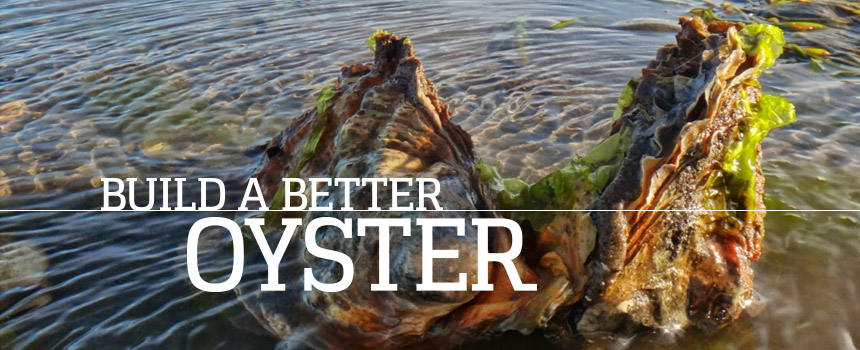Build a Better Oyster

“He was a bold man that first eat an oyster,” Jonathan Swift is reputed to have said. Bold, or maybe just hungry. Whichever it was, the reward must have been worth the risk, because humans have been prying open oyster shells and slurping down the salty-sweet meat for thousands of years.
The Pacific Coast’s cold ocean waters and extensive intertidal zones make for prime oyster-growing country. Oysters are not only good for you (high in protein, low in fat, and packed with minerals), they’re good for the economy. Oysters grown in Oregon, Washington, and Alaska have a dockside value of about $70 million a year.
And oysters are good for the environment, too. They’re filter feeders that remove particulate matter out of coastal waters and reduce the size of algal blooms. Oyster reefs create habitat for other bottom-living creatures; they stabilize coastlines and help minimize damage from storm surges.
“Oysters are an aquaculture success story. They’re one of our most sustainable fisheries,” says Gil Sylvia, director of OSU’s Coastal Oregon Marine Experiment Station.
[caption caption="OSU research has led to oysters that are plumper, tastier, and easier to shuck. (Photo by Lynn Ketchum.)"] [/caption]
[/caption]
The Northwest oyster industry has been going strong for more than a century. Most farmed oysters are Pacific oysters, imported from Japan in the early 20th century after heavy harvesting nearly wiped out the Northwest’s native Olympia oysters. Pacific oysters vary widely in survival, growth, and disease resistance. They also vary in shell size, color, and shape, all of which affect the market price for oysters and the efficiency of harvesting and shucking.
In the mid-1990s, Chris Langdon, a shellfish biologist at OSU’s Coastal Oregon Marine Experiment Station, started thinking about building a better oyster. Farmers on land have benefited from selective breeding of wheat, cattle, and hundreds of other crops. Why should oyster farmers be left out?
Langdon started the Molluscan Broodstock Program in 1996, with funds from a special federal appropriation. Today Northwest oyster growers are enjoying increased yields and profits from his improved mollusks. Langdon estimates that OSU’s better broodstock has increased commercial yields as much as 35 percent. The improvements have pulled an estimated $4.5 million per year into the Northwest’s seafood economy.
Breeding oysters is not quite like breeding chickens, Langdon says. “We can control their early life, but we can’t control the influences of the environment in which they mature. They depend on natural food and natural conditions.”
Oysters start their lives as fertilized eggs smaller than the tip of a human hair. Within 24 hours the larvae grow a tiny, hinged shell. In 2 or 3 weeks, when they are about the size of a grain of fine sand, they develop an appendage and go looking for something firm to attach to—rocks, concrete, ceramic tile. They prefer to settle on reefs of previous generations of oyster shells deposited in the intertidal zone.
Once attached, the young oysters undergo a metamorphosis, emerging as spat—tiny perfect oysters about as big as the point of a sharp pencil. They mature over 2 or 3 years, filtering nourishment from the tides that wash over them and growing about an inch in length each year.
The heavy influence of the environment on the oyster’s life cycle, says Langdon, means genetics plays a relatively lighter role. “Most of the traits we were interested in, such as survival and growth rate, are heritable,” he says, “but the heritability is very low. So it took us quite a while to see any improvement.”
[caption caption="Chris Langdon leads OSU shellfish research at the Coastal Oregon Marine Experiment Station in Newport. Improved oysters are more uniform in size and shape. (Photo by Stephen Ward.)"] [/caption]
[/caption]
Langdon started his broodstock improvement by collecting 600 Pacific oysters from different areas along the West Coast. Working at a pilot-scale hatchery at the Hatfield Marine Science Center, he began the long process of selection and crossing to develop pedigreed lines. He reared the offspring in the Hatfield Center’s pilot hatchery and then planted them out at study sites all along the Pacific Coast, from California’s Tomales Bay to Alaska’s Prince William Sound. After the oysters reached spawning age, he identified the ones with the best survival and growth, and crossed and recrossed them systematically until he started to see improvements.
To ramp up production to a commercial scale, Langdon crossed the top-performing families to produce genetically distinct “pods” of offspring. The pod-production was now ready for hand-off to the industry. A group of partners from the seafood industry have scaled up pod-production and are helping to fund Langdon’s ongoing rearing of larvae and spat. “The farmers now have a collection of pods,” says Langdon, “and they work with the hatcheries to cross the pods that will give them the qualities they want.”
The project has paid off in plumper, faster-growing, sweeter-tasting, easier-to-shuck oysters, says Paul Taylor of Taylor Shellfish, the nation’s largest producer of farmed shellfish and a long-time partner in the oyster-breeding program. “Initially we were going for growth, and that priority has not gone away,” says Taylor, whose family has been farming shellfish for five generations. Broodstock improvement has also achieved more-uniform size and shape, which makes harvesting, sorting, and shucking oysters much easier.
Another improvement was coloration of the shell and meat. Now oyster lovers can choose oysters with black shells, speckled shells and cream-colored shells, with meat the color of cream, the color of spindrift, the color of storm clouds. With their variegated appearance and deep, lustrous, meat-packed cups, these well-bred oysters make a stunning presentation.


